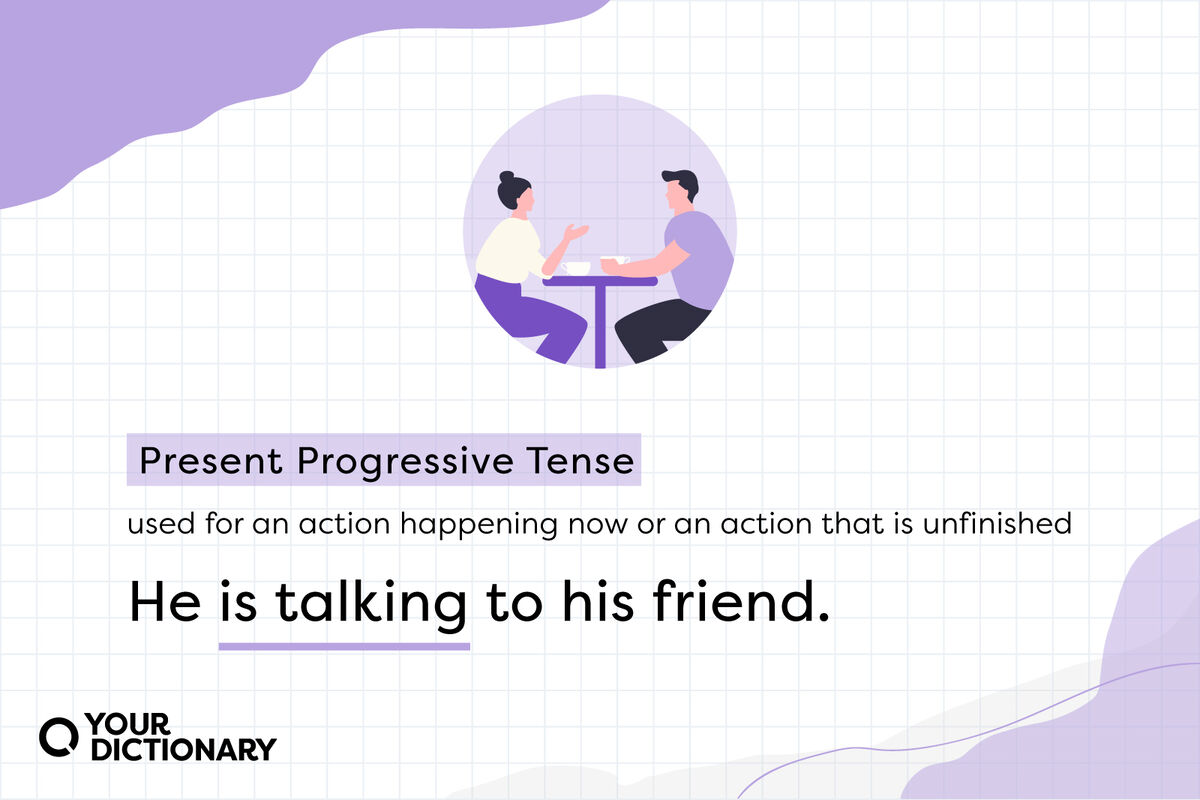
What’s the difference between “Ryan eats” and “Ryan is eating”? They’re both happening in the present tense, but only one of them describes an action that is happening right now. (Hint: It’s the one with the -ing ending.) Present progressive tense is more than just one more verb tense to remember — it’s the only way to show that an action is ongoing.
What Is the Present Progressive Tense?
The present progressive tense (also called the present continuous tense) is a form of the present tense that shows an ongoing action that is happening right now. It can also show that an action is continuing and is unfinished.
You can use the present progressive with any action verb that shows what a noun can do.
- She is crying.
- He is talking to his friend.
- The baby is sleeping in his crib.
- We are visiting the museum in the afternoon.
How To Form the Present Progressive Tense
You make the present progressive tense with a form of the verb to be (is/am/are) and the present participle of the verb (verb + -ing).
|
Present Tense Form of “To Be” |
Present Participle |
Example sentence |
|
is |
walk (ing) |
Laura is walking the dog. |
|
am |
study (ing) |
I am studying German. |
|
are |
eat (ing) |
We are eating dinner. |
Note that when you use the past tense form of to be (as in “Laura was walking the dog” or “We were eating dinner), you’re writing in past progressive tense — even though the main verb is in the -ing form.
How To Use the Present Progressive Tense
We already have the present tense, which shows us actions that aren’t happening in the past or the future — so why do we need present progressive tense?
We primarily use present progressive or continuous tense to show an action that is happening right at this moment, but we can also use it to show an ongoing action over a period of time or even to show an action that will happen in the near future.
Present Progressive Tense Examples Showing Actions Happening Right Now
Present progressive tense can show us an action that is happening right this minute. If you could see the subject of the sentence, you’d see them performing the action right now.
- Marc is making pizza.
- They are eating lunch.
- Frances is talking on the phone.
- We are driving in the car.
Present Progressive Tense Examples Showing Actions That Are Not Happening Right Now
Present continuous tense can also show something that is not happening right now. Just add the negative word not (or the contraction isn’t or aren’t).
- He is not standing.
- Anthony isn’t sitting in the chair.
- You are not watching the movie.
- Rose isn’t reading a book.
Present Progressive Tense Examples Showing Ongoing or Unfinished Actions
Sometimes an action is happening now, but it’s going to last longer than this moment. You can use present progressive tense to show unfinished actions that haven’t quite entered the past tense yet.
- Tom is arriving at 5:00.
- I am failing history class.
- We are attending Yale University.
- She is getting married.
Present Progressive Tense Examples Showing Repeated Actions
Use the present progressive tense to describe actions that happen over and over again. Adverbs like always, constantly, and forever often appear along with the verb.
- Jack and Jill are always fighting.
- She is constantly complaining about her sister.
- Her mother is forever misplacing her keys.
- You are always bothering me about homework.
Present Progressive Tense Examples Showing Actions That Will Happen Soon
Present continuous tense can show that something will or will not happen in the near future.
- Ken is visiting his cousin this weekend.
- We are leaving for the beach tomorrow morning.
- The kids are arriving at six o'clock.
- She is speaking at the conference this evening.
Present Progressive Tense Examples Showing Current Trends
Use the present progressive tense when speaking about current trends.
- Shopping online is growing in popularity nowadays.
- The stocks are dropping because of the economy.
- Today, most people are using text messages instead of the phone.
- Children are learning advanced math in elementary school.
Examples of Present Progressive Tense in Questions
Use present continuous tense in questions to ask about whether an action is happening now (or in the near future). Just put is, are, or am first, then the subject of the sentence, and then the main -ing verb.
- Is she laughing?
- Are they listening to the teacher?
- Am I driving too fast?
- Is the baby drinking his bottle?
When Not To Use Present Progressive Tense
Not all verbs can be progressive. While action verbs can happen right now, stative verbs show states of being, senses, or emotions. They are known as non-continuous verbs, and you don’t need to put them into the present progressive or present continuous tense when they’re happening right now — the present tense does just fine.
- Awkward - I am agreeing with you.
- Correct - I agree with you.
- Awkward - We are loving each other.
- Correct - We love each other.
- Awkward - Laura is seeing the car approach.
- Correct - Laura sees the car approach.
- Awkward - The class is understanding how to write an essay.
- Correct - The class understands how to write an essay.
A Work in Progress-ive Tense
Forming the present progressive tense seems simple enough, and it really is — but that doesn’t stop verb tense errors from sneaking into everyone’s writing. Once you know why you’re using present progressive tense, you’re sure to get your sentences in order.